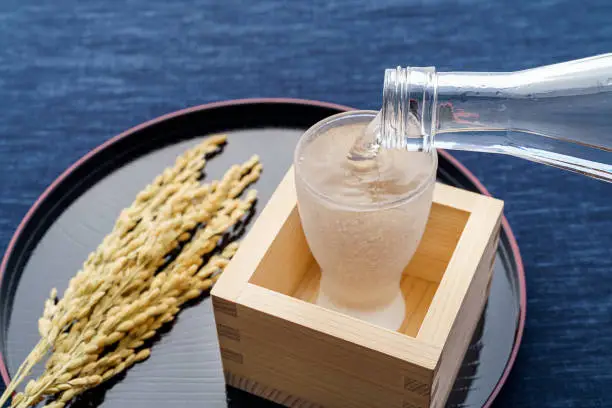Bubbles and Bliss: Discovering the Delightful World of Sparkling Sake
Sparkling sake, a refreshing and lightly effervescent variation of traditional sake, started to gain popularity in Japan around the early 2000s. Before this period, it was an obscure drink enjoyed by only a small number of enthusiasts.
This sudden interest in sparkling sake steamed from Japanese breweries’ innovative marketing strategies at the AWA. For instance, Mio Sparkling Sake from Takara Shuzo – arguably one of the pioneers that triggered the boom – was created with these audiences specifically in mind. Mio’s distinctive sweet taste combined with light bubbles appealed instantly not just domestically but also internationally.
In this article, we will explore the unique features of this emerging experience and tips for creating the best sake-tasting experience.
Understanding the Unique Features of Sparkling Sake
Sparkling sake, particularly Mio sparkling sake, is a delightful variant in the family of Japanese rice wines. Its unique features are due to its brewing process and specific ingredients.
The Lightness of Sparkling Sake
The lightness that characterizes sparkling sake comes from two aspects: alcohol content and flavor intensity. Typically, this beverage has an alcohol percentage between 5% to 13%, much less than traditional sakes which can reach up to 21%. This makes it easier on your palate and is perfect for those who prefer their drinks milder.
Furthermore, Mio’s sparkling sake offers a gentle sweetness with fruity notes that don’t overwhelm but instead add depth to each sip. Think about biting into a ripe peach or taking in the aroma of fresh strawberries – subtle yet memorable.
Cool Serving Temperature – An Icy Twist.
Much unlike traditional hot-served sakes where heat intensifies flavors & aromas, sparkling sake is best enjoyed chilled. A lower temperature complements its lighter profile and brings out the fizz.
So, imagine a hot summer day – you’re seeking refreshment and there’s Mio sparkling sake. Cold, bubbly, and light on alcohol yet full of subtle flavors; it’s almost like having your favorite fruit spritzer with an exotic twist.
Pairing Sparkling Sake with Desserts
Imagine a match made in gastronomic heaven: the delicate bubbles of sweet sparkling sake dancing on your tongue, paired perfectly with the sweet richness of desserts. It’s no wonder that sake experts often recommend this combination.
Mio sparkling sake, known for its light and fruity profile, makes an excellent companion to various desserts. The balance of Mio’s subtle sweetness doesn’t overpower dessert flavors; instead, it complements them beautifully.
The Science Behind Pairing
Pairing foods and beverages isn’t random – there’s science behind it. Essentially, food pairing relies on balancing different taste elements: sweet pairs well with sweet but also works wonders cutting through rich or fatty flavors.
This principle explains why Mio sparkling sake is such a fantastic partner for cake or pudding – its natural sweetness matches these treats while the carbonation helps cleanse your palate between bites.
Tasting Tips from Experts
For best results when enjoying dessert with sparkling sake:
- Serve chilled (around 5-10°C) to highlight freshness;
- Glass selection matters. Use a flute sparkling glass to appreciate the aroma and flavor.
Sparkling Sake vs. Traditional Sake
The world of sake is rich and diverse, with two distinct types capturing the attention of connoisseurs: sparkling sake and traditional sake. These varieties differ in several key aspects.
Different Production Methods
Traditional sake uses a time-honored method known as multiple parallel fermentation. But AWA Sparkling Association’s sparkling sake undergoes secondary fermentation within the bottle to create its signature bubbles, similar to champagne production.
This unique process gives rise to light-bodied sakes that are less intense in flavor compared to their traditional counterparts.
Variation in Alcohol Content and Flavor Profile
Mio Sparkling Sake, renowned for its gentle sweetness and fruity aroma has an alcohol content hovering around 5%, which is notably lower than typical sakes that range between 15% and 20%. This makes it a great entry point into the fascinating world of Japanese rice wine.
The bubbly nature also adds another layer of complexity to your palate – something you don’t get from still or regular sakes. It’s almost like tasting prosecco after being accustomed only to chardonnay.
Affinity for Different Occasions
Serving occasions vary between these beverages as well. While both can be enjoyed at celebrations or casual gatherings, there’s no denying how well sparkling variety pairs with desserts such as cakes or puddings due to its refreshing taste profile.
Fitting Glassware Choices
To truly appreciate each sip, glassware plays a significant role. Traditional sake is often served in small ceramic cups called ‘ochoko’ while the fizzy variant like Mio, benefits from flute glasses to maintain its effervescence longer.
Despite their differences, both sparkling and traditional sakes have an important place on the table of Japanese spirits. It’s all about personal preference and occasion.
How to Enjoy Sparkling Sake at Its Best
Serving sparkling sake correctly can enhance its taste and your overall experience. The first step is temperature; chill it in the fridge, but not too cold. Aim for around 5-10°C (41-50°F), a bit cooler than room temp but warmer than your average white wine.
Glassware choice also plays a role. Use flutes or tulip-shaped glasses, similar to those used for Champagne. These types of glasses help retain the bubbles and aromas better.
Pouring Technique Matters
The way you pour sake matters just as much as how you serve it. Start by tilting the glass slightly. Pour slowly down the side to preserve those delicate bubbles we love so much.
If there’s sediment at the bottom of your bottle (called kasu), don’t worry—it’s totally normal. Just give it a gentle swirl before pouring.
Pair It Up Right
Sparkling sake pairs well with various foods due to its crisp and refreshing effervescence. For an exquisite pairing, try this bubbly delight with desserts like cake or pudding – they make for a surprising yet delightful combo.
Becoming A Sake Savvy
Sake School of America offers courses that can turn anyone into a certified sake advisor. Our course will deepen your understanding of different types of sakes including sparkling ones, letting you enjoy them even more.
With these tips, you’re ready to savor sparkling sake at its best. Remember, the key is to chill it just right, choose your glass wisely and pour with care.


